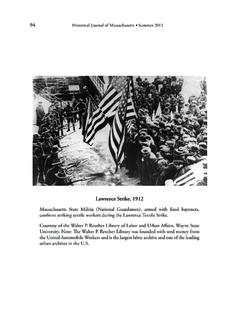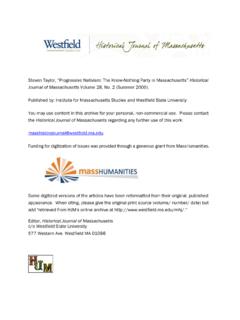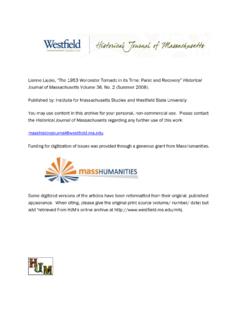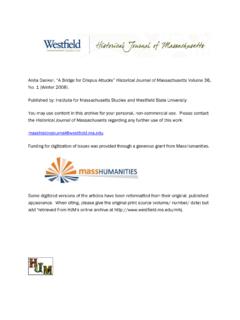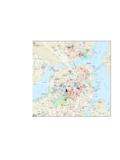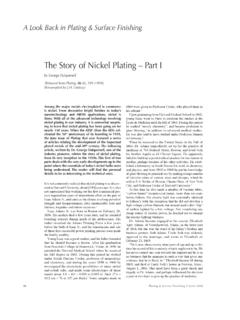Transcription of Huguenots Fleeing France, 1696 - Westfield State …
1 Historical Journal of Massachusetts Summer 2012122 Huguenots Fleeing france , 1696At least 200,000 Huguenots are believed to have fled france in the years surrounding 1685, ending up in places as far afield as North America, the Dutch Republic, England, Ireland, Germany, Switzerland, and South Identity and Protestant Unity in Colonial Massachusetts:The Reverend Andr Le Mercier and the Sociable Spirit Paula Wheeler CarloAbstract: Numerous researchers have noted that many Huguenots conformed to Anglicanism several decades after their arrival in North America. The situation differed in colonial Massachusetts, where Huguenots typically forged connections with Congregationalists or Presbyterians. This article explores the activities and writings of Andr Le Mercier (1692-1764), the last pastor of the Boston French Church, which closed in 1748. Le Mercier was an ardent supporter of Protestant unity, yet he also strove to preserve a strong sense of Huguenot identity.
2 Nevertheless, support for Protestant unity facilitated Huguenot integration into the English-speaking majority, which fostered the demise of French Reformed churches in New England and thereby weakened Huguenot identity. Paula Wheeler Carlo is a professor of history at Nassau Community College and the author of Huguenot Refugees in Colonial New York: Becoming American in the Hudson Valley (Sussex Academic Press, 2005). * * * * *Historical Journal of Massachusetts, Vol. 40 (1/2), Summer 2012 Institute for Massachusetts Studies, Westfield State UniversityHistorical Journal of Massachusetts Summer 2012124 The Huguenots were French Protestants who followed the teachings of the religious reformer John Calvin (1509-1564).1 They faced persecution and even death during the French Religious Wars in the second half of the sixteenth c ent u r The conclusion of these wars produced the Edict of Nantes (1598), which allowed Protestants to freely practice their religion in specified areas of france .
3 After the assassination of King Henri IV (1553-1610), a one-time Huguenot, the provisions of this Edict began to be eroded. As persecution of Protestants intensified and their faith was declared illegal throughout predominantly Catholic france in 1685, many Huguenots sought refuge in Protestant states such as the Netherlands, Dutch-controlled South Africa, Swiss city-states, the Palatinate, Great Britain, and in the British North American colonies. Some 30 years ago the late historian Robert M. Kingdon sought to answer the question, Why did the Huguenot refugees in the American colonies become Episcopalians? Kingdon identifies numerous reasons for Huguenot conformity to the Church of England, which in the United States became known as the Episcopal Church after the American Motivations included financial incentives; social, economic, and political advantages; gratitude for toleration and a place of refuge; and perhaps an attraction to Anglican In the conclusion of this classic essay, Kingdon mentions yet another possible motivation for conformity to Anglicanism: the desire for Christian unity.
4 In support of this, Kingdon cites Andr Le Mercier (1692-1764), the last minister of the French Calvinist church in Boston. Kingdon describes Le Mercier as perhaps the most literate of the Huguenots to come to America. Le Mercier had written the following in a 1732 publication: There is a great difference between Articles of Doctrine and Points of Discipline. One may in this last respect conform himself to the ways of the Places where he liveth .. without any prejudice to his Religion and [As] to Articles of Discipline, we must be of a sociable Spirit, and submit to the order of the Churches among which we live; because order is not an unalterable thing .. it depends upon the circumstances of times and places; so that it may be very well said of two opposite forms, that they are both of them good. Based on this passage, Kingdon theorizes that Le Mercier was suggesting that there is no one way in which a true Christian church must be organized.
5 Kingdon further observes that 125this view would not have been acceptable to English Presbyterians or Congregationalists of the period and would not have pleased many Episcopalians either. But if it was widespread among the Huguenots who emigrated to the American colonies, [it] may ..explain why it was so easy for the French refugees to discard the ecclesiastical structures to which they had been accustomed ..and which may have led them into Episcopal Kingdon s speculation helps to explain the Huguenots easy embrace of Anglicanism. But Andr Le Mercier, who was the pastor of a French Calvinist church that did not conform to Anglicanism, appears to be a strange example. Still, his writings and career suggest that the spirit of Protestant unity was vibrant even among Huguenots who did not conform to the Church of England. This article explores how the spirit of unity was encouraged in Le Mercier s publications, manuscript sermons, and in a cooperative presbytery that he formed with New England At the same time, Le Mercier promoted a distinctive sense of Huguenot identity by emphasizing the tenacity of their religious devotion and their unique role within international Protestantism.
6 The Church of England is widely regarded as a Protestant denomination. Yet, it shares several characteristics in common with the Roman Catholic Church. Therefore, some of its teachings and practices differed from those of the Calvinists. One of the major disagreements concerned church organization. Calvinists typically had little or no hierarchy outside of the local church and did not recognize the office of bishop or archbishop, while the Church of England recognized these offices, which is the origin for the term Huguenot Identity and Protestant Unity in Colonial MassachusettsHugues CapetSome believe that the origin of the term Huguenot which was used after 1560 to refer to French Protestants derived from the name given to those who supported claimants to the French throne who could trace their descent back to Hugues Capet, a tenth-century French Journal of Massachusetts Summer 2012126 Furthermore, Calvinists observed only two sacraments: baptism and communion.
7 Unlike Catholics, they did not believe that any of the sacraments granted salvation from eternal punishment in hell and assured entrance into heaven. The Church of England, in contrast, recognized all of the seven sacraments that the Roman Catholic Church did. But the Church of England accorded lower status to the five sacraments other than baptism and communion and referred to them as the lesser five. Like other Protestants, Anglicans did not believe that any of the seven sacraments conferred salvation. However, the Church of England had a more ritualistic form of worship and Anglican churches (particularly in Great Britain) were more ornate than those of the Calvinists. What all Protestants shared in common was a belief in justification or salvation by faith rather than through works or sacraments. Simply put, this Reconstructed French Church with stone wall and burial ground, Historic Huguenot Street, New Paltz, NY.
8 Boston s French Church may have been similar since many churches were square in shape during the colonial that if someone did not possess the necessary faith in God and in the sacrifice of Jesus Christ, no amount of good works or sacraments could save that person from eternal damnation in hell. Additionally, Protestants allowed their clergy to marry, they did not believe in Purgatory, they did not venerate or pray to saints or to the Virgin Mary, laypersons were allowed to read the Scriptures in their own language, and services were conducted in the vernacular rather than in Latin. In the early seventeenth century these differences had led to the persecution of the Pilgrims and Puritans (who strove to purify the Church of England of its popish practices), thus prompting many of these English Calvinists to leave their Le Mercier was born in Normandy, france in 1692. He completed his theological studies in 1715 at the Geneva Academy, which had been founded by John Calvin and other Protestant reformers in Geneva, Switzerland in 1559.
9 Subsequently, Le Mercier went to London where he was recruited by Andr Faneuil, a prosperous Boston merchant and fellow Huguenot, to become the minister of the French Church in Le Mercier, who was proficient in French, English, and perhaps several ancient languages, arrived in Boston in 1716. At that time, the Boston French Church was the only Huguenot church in New England. Previously there had been small Huguenot congregations in Narragansett, Rhode Island (1687-1691), and Oxford, Massachusetts (ca. 1691-1704). But as historian Jon Butler notes, these churches quickly disintegrated because of internal disputes, financial problems, and Indian attacks. Some of the Huguenots from these beleaguered settlements relocated to Boston. Consequently, after 1696 there were over forty Huguenot families living in Some of these families became well known and prosperous through their early involvement in Boston s political and economic life.
10 Among the more prominent Huguenot merchants were Andr Faneuil, James Bowdoin, and Daniel Johonnot. Faneuil was also active in politics, as were John Foy, John Barbour, and James LeBlond, all of whom were elected as city constables between 1704 and Mercier soon established himself as a respected community member and intellectual force, with several publications to his credit. He was consulted by persons outside the Huguenot community and was an essential member of Calvinist circles in New England. Despite Le Mercier s wider connections, dedication, and intelligence, the French Church in Boston experienced dwindling membership rolls and finances. Reasons for this downturn included intermarriage, political achievement, apparent economic success, and shifts in church membership, which fostered Huguenot assimilation into the predominantly English The decline in attendance Huguenot Identity and Protestant Unity in Colonial MassachusettsHistorical Journal of Massachusetts Summer 2012128A plaque now marks the spot where the French Church in Boston once stood at 24 School Street.
